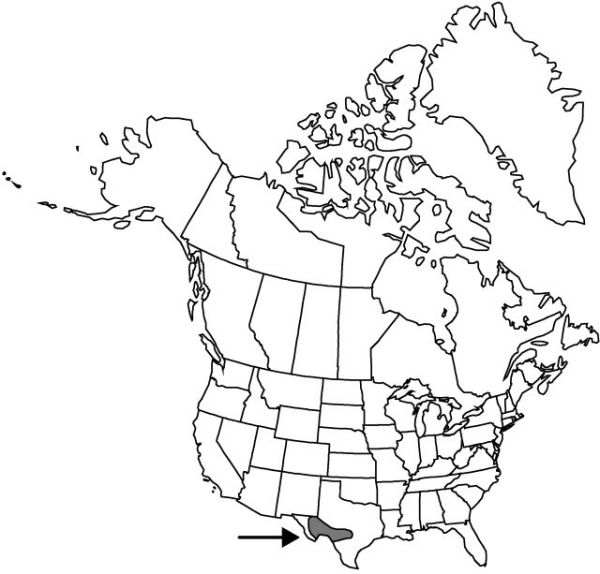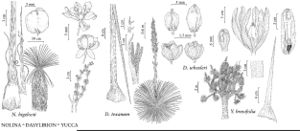Dasylirion texanum
Linnaea 23: 140. 1850.
Plants typically small, with small crowns; trunks usually less than 0.5 m. Leaves narrow, arching gently downward, often twisting outward toward tip; blade usually shiny, bright green, 70–130 × 1–2 cm wide above broadened base, glabrous, not waxy, smooth; prickles mostly antrorse. Inflorescences 2–4 m; stalk 1.5–3 cm diam. at base; branches mostly basal, erect, 2.5–6 cm; bracts lanceolate; fascicles of flowers condensed, 5–8 cm from base to tip; primary axes 0.5–1 cm. Flowers with receptacles ca. 0.2 mm; tepals whitish or greenish, 1.5 × 1 mm; style ca. 0.2 mm; stigma lobes 0.2–0.3 mm, loosely united; pedicel 2.2–3 mm in fruit. Capsules ellipsoid, 5.5–6 × 4–5 mm, distal wing lobes 1–1.5 mm, evenly rounded in cross section, not indented. 2n = 38.
Phenology: Flowering May–Jul.
Habitat: Open, rocky limestone slopes, arroyos and canyons, dry limestone hills
Elevation: 600–1800 m
Distribution

Tex., Mexico (Coahuila).
Discussion
Dasylirion texanum is often small, but can become quite large in moist situations. It is relatively homogeneous in the northeastern portion of its range in east-central Texas. In west Texas, plants are larger and have both antrorse and retrorse prickles. These have been included in D. heteracanthum I. M. Johnston, but they are probably hybrids between D. texanum and D. leiophyllum, in which the prickles are retrorse. There is little mixing of these two species except in a narrow zone extending northward through the Chisos, Davis, and Guadalupe mountains in west Texas.
Selected References
None.
